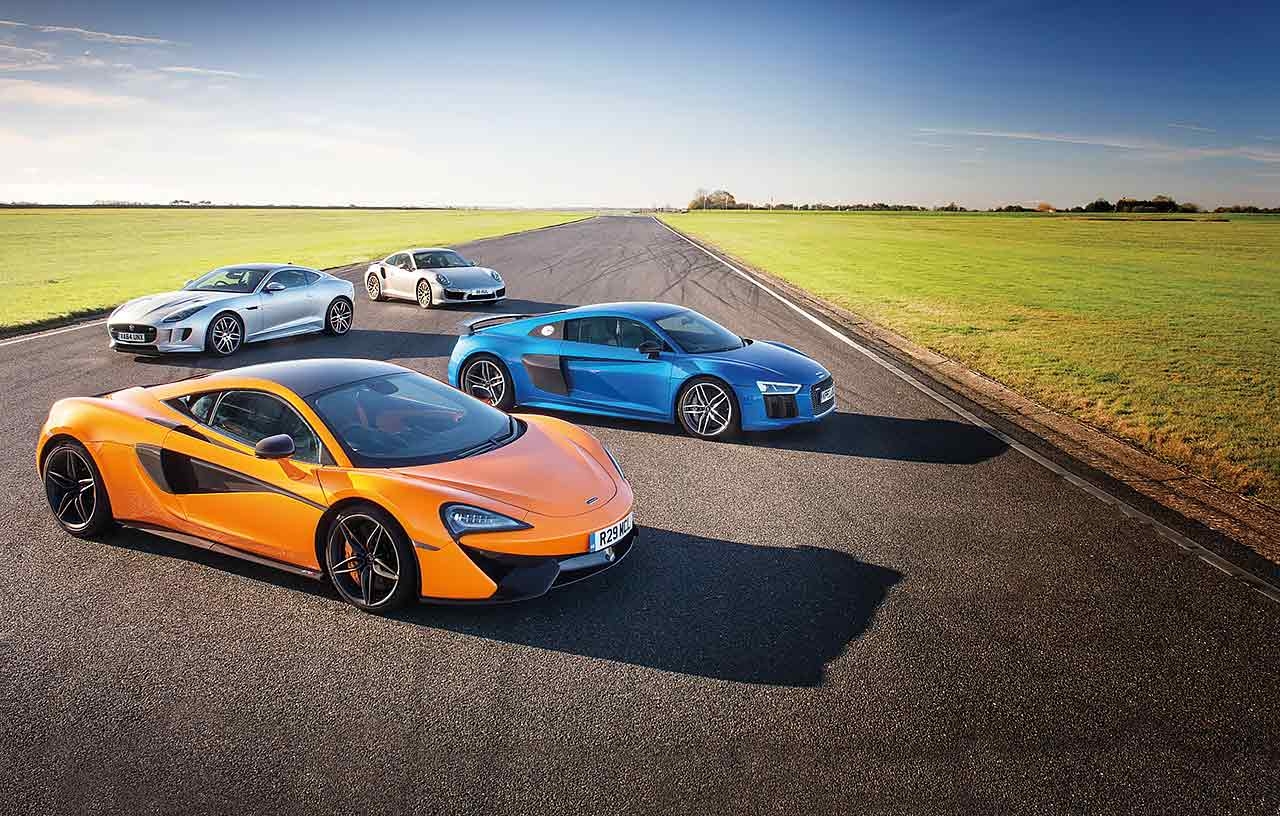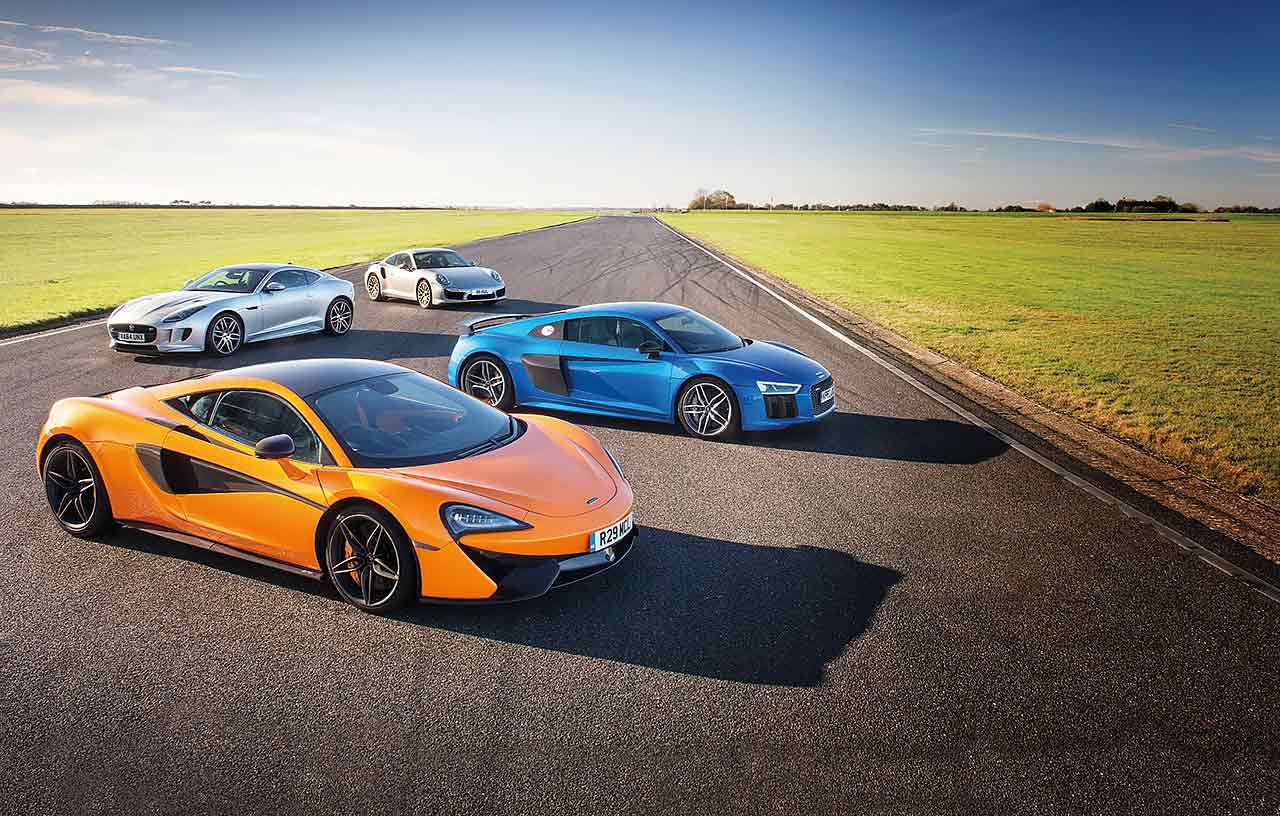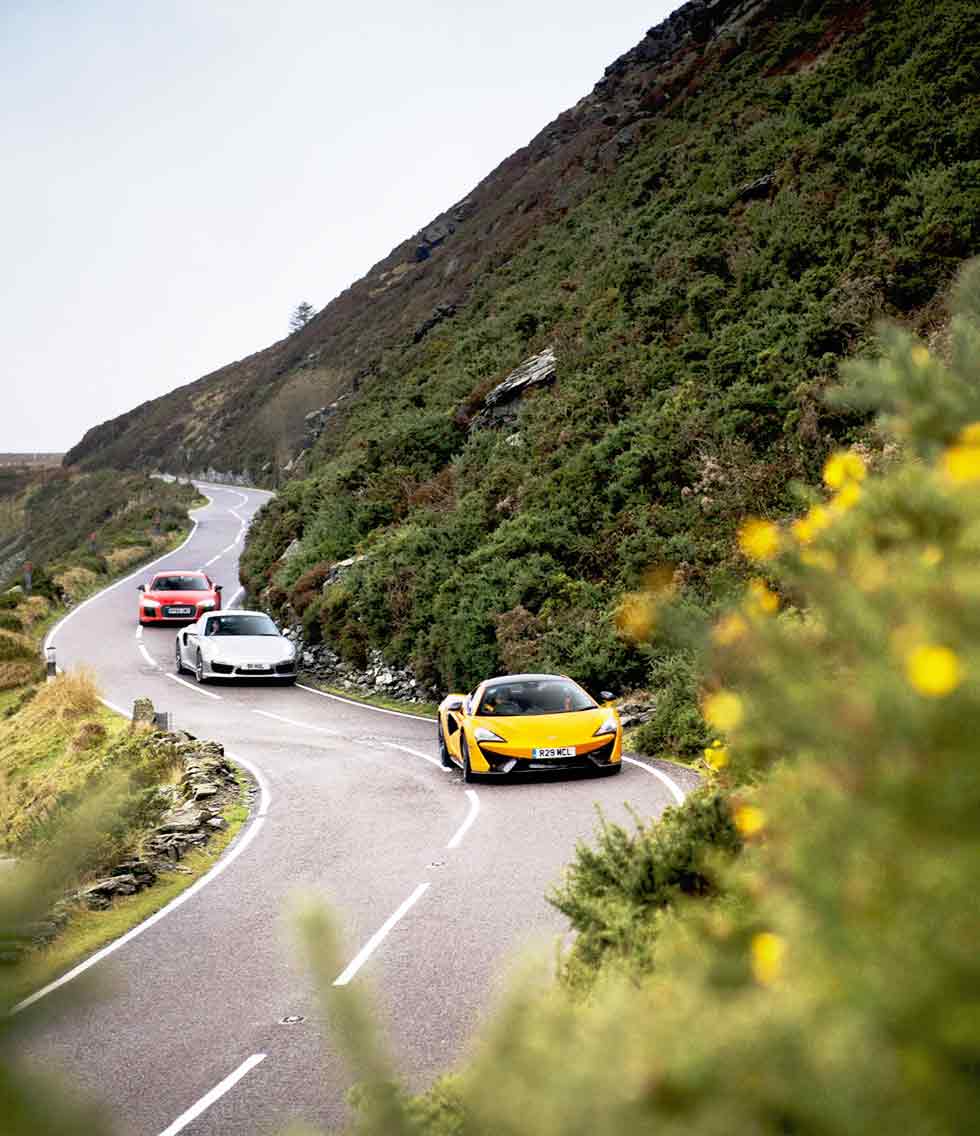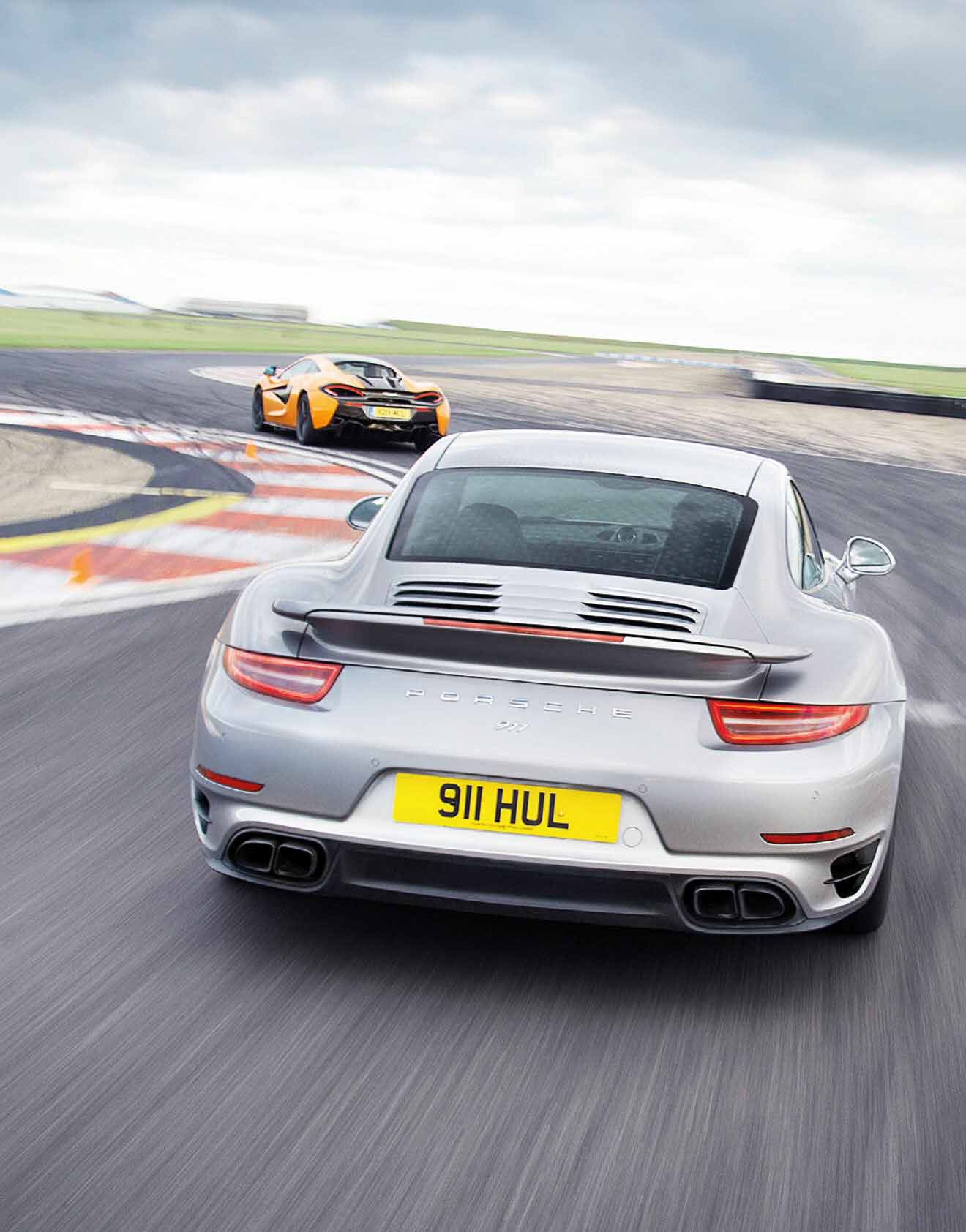
You’re hardwired into the McLaren, downloading its messages and uploading your inputs on intuition.
GROUP TEST: McLAREN 570S EVERY DAY HEROES
McLaren 570S v new Audi R8 V10 Plus v Porsche 911 Turbo S 991 v Jaguar F-type R AWD. The 911 Turbo S 991 defines the everyday all-weather supercar, but now it’s challenged by the brilliant new McLaren 570S and Audi R8 V10 Plus and the fearsome Jaguar F-Type R AWD. Words by Dan Prosser. Photography by Aston Parrott.
PART 1 Our contenders’ all-weather ability is tested to the limit on (very) wet Welsh roads.
PART 2 Dry roads – and the Bedford Autodrome – reveal which delivers the biggest thrill.

TO WET WALES… Part 1.
Little bitty stingin’ rain. Big ol’ fat rain. Rain that flies in sideways. Even rain that seems to come straight up from underneath. And all of this before we’ve eaten breakfast. If we could only know how spectacularly wrong the forecast for tomorrow will prove to be, we’d cut our losses and run right now. But with the weather apps on our phones telling us the rain will ease off this evening, we decide to persevere.
I REMIND MYSELF NEVER TO TRUST ANOTHER WEATHER FORECAST
On we drive through Snowdonia. The peaks that surround the Llanberis Pass form a sort of enormous geological funnel, collecting vast quantities of water and depositing every drop, it seems, directly onto the A4086. The road is laced with streams so I lead our convoy with some degree of caution, but hopefully not so much that my colleagues will think I’ve gone soft. I see another stream up ahead and make note of it, but as I get closer it seems to grow. It’s more of a river. It’s deep. I realise just in time just how deep it really is, so I stand on the brakes to shed as much speed as possible, point the McLaren down the middle of the road and release the brake pedal an instant before hitting the river.

The Pirelli P Zero Corsa is not designed to displace water. The four tyres start to plane the moment they hit the river. Great sheets rise up either side of the car as it skates across the road towards a stone wall. It probably looks quite dramatic from the outside, but the sheep don’t seem to notice. I suspect Henry Catchpole behind me definitely does.
The river runs dry just in time, so the tyres find enough purchase on the road surface to keep me out of the wall. I decide to slacken the pace. I have clearly gone soft. The conditions are supposed to be improving, but if I knew right now that the rain will actually fall unabated for the next two days I’d continue on along the A4086, pick up the A5 at Betws-y-Coed and drive home.
UNDER POWER AT THE CORNEREXIT, THE 911 FINDS BETTER TRACTION
Slowly, we splash on towards Bala. It’s frustrating to be learning so little about the 570S, particularly when time is already tight, but, given that each of the cars on this test bills itself as an everyday ride, perhaps wet-weather ability should be part of the discussion.
The 911 Turbo S 991 has long been the definitive daily-use, all-weather supercar, although the R8 V10 Plus has challenged for that title in recent years. Priced at $444,500 and a predicted $400,000 respectively, they are the heartland at which the $408,000 McLaren is targeted. The Brit is on the money for power output, too: 419kW plays the Porsche’s 412kW and the Audi’s 449kW. (Porsche has just announced more powerful, faster and more expensive 991.2 Turbo and Turbo S models.)
Jaguar’s F-type R Coupe is here as the value proposition. In All Wheel Drive form, it costs $260,980 but with 404kW it should have the firepower it needs to keep pace with the competition. Certainly, like the Porsche and Audi, its all-wheel-drive system gives it a wet-weather advantage over the 570S.
Sure enough, the McLaren is hamstrung by the weather, but it isn’t all bad. For one thing the hydraulically assisted steering is wonderfully detailed on these textured roads. On the smooth, glassy surfaces of the Portuguese launch route, I found the steering to be short of any meaningful feel in similar conditions, but here it gives you a clear indication of grip levels. The traction control system, meanwhile, does a good job of maintaining control at the rear axle without completely cutting drive. After turn in, the outer pair of tyres really dig hard into the road surface, too, which means you can actually lean on the chassis. So you find yourself carrying reasonable speed down a road with confidence, short-shifting to avoid asking too much of the traction control.
Ultimately, the 570S is limited by its aggressive Corsa tyres. Push a little harder into a corner and you’ll soon feel – with real clarity – the front axle wash wide. McLaren offers a non-Corsa P Zero for the 570S and for most drivers and situations it’s surely the sensible option.
That’s the tyre Porsche uses on the 911 Turbo S and the advantages over the Corsa are pronounced. Being a 911, there is still an understeer window through which to drive, but that’s in the chassis rather than the tyre.
Trail-brake into bends and the P Zero finds good turn-in bite through the layer of slickness. Midcorner grip is stronger, too, and under power at corner-exit the all-wheel-drive Porsche finds better traction, but there is actually a propensity for the rear axle to be overwhelmed if you try to deploy the full 750Nmin these conditions. There’s a surprising amount of yaw with the stability control system left on, but never beyond a certain point. The Turbo S does slither down a wet road, then, but it clips along at a faster rate than the McLaren nonetheless.
For wet-weather dynamic ability, the Porsche has met its match in the R8. On its Continental Sport Contact 6 rubber, the Audi finds equally impressive turn-in grip, but with a little less understeer. It also grips hard mid-corner, but its traction under power is more resolute – a result not only of its very quick-witted all-wheel-drive system but also its less demanding 540Nm. On the few occasions that you do ask too much of the four contact patches away from a corner – perhaps if the tyres are still dealing with the cornering force – the R8 is very lively, snapping into oversteer suddenly if you’ve dared to remove the electronic safetynets. In this moment, the car feels as though it has a wide track and a short wheelbase.
The Porsche, Audi and McLaren all bite hard into the road surface at mid-corner to give you a degree of confidence in these treacherous conditions. The Jaguar, however, does not. Rather than sense the F-type’s weight settle onto the outer edge of the car, it feels as though its P Zero rubber is right on the edge of letting go and sending the car into a slide. It isn’t very often that it actually happens, but that impression, corner after corner, does erode your confidence. The remote, elastic feeling steering also self-centres so aggressively after turn-in that you lose all sense of the grip levels across the front axle.
This AWD Jaguar car does at least make vastly better use of the supercharged V8’s power and torque than the rear-wheel-drive version does in such weather. That car is so severely traction limited in the rain that you tend to give up any notion of driving quickly at the first sight of a threatening cloud, but in this model you can continue pressing on. There is still a reasonable amount of exit oversteer if you stand on the throttle early, but you immediately feel drive being sent forwards and the car being hauled straight again. It’s actually rather a lot of fun. ‘‘I normally wouldn’t venture anywhere near the F-type’s wet weather mode, but it really is that wet today,’’ says Henry. ‘‘It does a great job of softening the throttle response and generally making the car more driveable.’’
With the rain showing no sign of easing, there’s absolutely nothing to be learnt about the dry weather behaviour of the cars, so to pass the time I consider their day-to-day merits. They do, after all, tend to be an only car rather than part of a bigger fleet. That’s certainly the brief McLaren set itself for the 570S, and a number of measures were taken to make it more agreeable in everyday use than the 650S. There’s more stowage space in the cabin, for instance, and the carbon tub has been modified to improve access. Lowering the sill by 80mmat the point where your feet pass over it has made some difference, but the rest of the sill is still high and the showpiece butterfly doors do require you to stoop down low to clear them.
The quality of the materials and build within The cabin is very good, though, and the dash shows real design flair. The brightly coloured leather door panels of this particular test car won’t be to all tastes, but at least the cabin is in no way dour. With all the nav, stereo and ventilation controls Nestled within the IRIS touchscreen system, there is inevitably a period of familiarisation during which time the simplest operations can be quite baffling, but you do soon learn them.
The Jaguar’s cabin immediately gives it the impression of being a much bigger, weightier car, which isn’t helped by the annoyingly doughy steering wheel. The second impression is of slightly patchy material quality in some places, although it’s worth remembering that the cheapest derivative of the F-type is a $119,080 car. Being a less exotic sort of creature, the Jaguar does seem a more likely everyday machine, although, once you’ve folded yourself into the 570S’s cabin, there’s no real reason why the McLaren should be any more taxing day to day. It actually has a more relaxed and cushioned ride quality than the Jaguar, which can feel brittle over a rough road surface.
The Porsche’s cabin feels very understated compared with the McLaren’s and, to a lesser extent, the Jaguar’s, almost to the point of being functional and no more. At least the quality is very good. The Turbo S rides with some of the firmness of the F-type, feeling quite tight-limbed over certain road surfaces. Those small rear seats are a massive boon for anybody with young children, though.
On Audi Magnetic Ride dampers the R8 rides with some of the fluidity of the McLaren. Add to that the highest quality cabin here and the R8 is probably the most amenable everyday car (for those who can do without the 911’s rear seats, at least). Despite this test car having a very dark cabin, it feels like a tremendously exciting place in which to sit, while the infotainment functions are all pretty intuitive.
These are not the usual observations of an evo supercar test. Still the rain falls, so we scrap around to bag a few more photographs before calling it a day. We’ll awake in the morning to much sunnier scenes, I reassure the others. We do not. I don’t know if my fading sense of humour is just getting the better of me, but if feels even darker, wetter and colder this morning.
With all the foolhardiness of the few Snowdonia hikers who laced up their boots this morning, we press on with the photoshoot, adding whatever we can to yesterday’s fairly paltry haul of pictures. Then the Audi suffers a minor electrical fault after being launched through a big puddle (hopefully that’ll unravel the mystery of the colour-changing R8), photographer Aston Parrott declares the whole thing a waste of time, And Henry and I decide we’re learning nothing of any real value. We take refuge in a small café and scramble plan B.
Leaving rainpocalypse behind us, we head home that afternoon. We’ll meet next morning at the Bedford Autodrome. Not only does that give us the best opportunity to finish the photoshoot in the limited time we have left, we’ll also be able to test the cars on dry and familiar roads close to the circuit. I remind myself never to trust another weather forecast.
FOR WETWEATHER DYNAMIC ABILITY, THE PORSCHE HAS MET ITS MATCH IN THE R8
Above: newR8 V10 Plus packs a mighty 449kW, but also a super-sophisticated AWD system to keep it in check on days like this. Jaguar has AWD too, but struggles to find the same bite, as does rear-drive, P Zero Corsa-shod McLaren.
TO THE TEST TRACK! Part 2.
Two of these cars are so tremendously exciting at low speed, albeit for very different reasons, that you could fall for them without ever driving with any great purpose. To sit in the McLaren’s driving seat is to feel as though you’re piloting a Le Mans prototype. The seating position places your legs way out in front of you with your body reclined slightly and the steering wheel offered to your chest. The wheel itself is small, with a thin rim and slender spokes. You feel as though you’re sat right over the front axle with the weight of the car behind you, placed low in the carbon tub with a cinematic view forward over the low scuttle. It’s just so evocative. ‘‘I adore the driving position in the 570S,’’ agrees Henry. ‘‘Those optional bucket seats are absolute marvels that let you sink right down into them, giving great lateral support. The fact that the steering wheel comes so far out makes the seating position perfect.’’

Then you start to drive and even at town speeds you enjoy the tactility of that wonderfully detailed steering and the balance and low-slung centre of gravity of the chassis.
THE AUDI WILL SLIDE LIKE THE BEST OF THEM, REACHING ENORMOUS ANGLES OF SLIP
The R8 also has an evocative driving position – this time you’re sat right in the middle of the chassis with the windscreen way out ahead of you, more like a DTM racer than a Le Mans car – although it’s the naturally aspirated V10 that steals the show. Somehow just knowing that it’s over your shoulder, with its near-9000rpm redline and hummingbird responses, is enough. But, when you do wind it all the way out, the immediacy, the energy through the rev-range and the fury of the soundtrack right at the top end floods you with adrenalin.
The F-type’s blood-and-thunderV8 is enormous fun in its own way, especially now we’re on the thankfully dry roads of Bedfordshire and getting to use more of its full potential, but it feels crude compared with the Audi’s V10. In Dynamic mode, the Jaguar’s throttle calibration becomes so aggressive that you seem to get a full throttle opening at half pedal travel. Combined with the immediate response of a supercharger, it means you spend the first few kilometres deploying too much power far too early in the corner, which can upset the chassis. Soon enough, though, you learn to tickle the throttle pedal initially to modulate the input.
It’s one example of the F-type’s hyperactivity, which, it seems, has been engineered-in to disguise the car’s weight. Jaguar quotes 1730kg, but, given that we weighed a rear-wheel-drive V8 R Coupe at 1800kg, it seems likely that the All Wheel Drive model is closer to 1900kg (the all-wheel-drive system adds 75kg, according to Jaguar). The initial steering response is very sharp, too, and the front axle darts into an apex with an almost jumpy immediacy. The rear axle, meanwhile, feels very stiff in roll, so it’s always on the edge of sliding. For the most part that strategy does make the F-type feel very lively and agile indeed, but, when the direction changes come thick and fast and one undulation rolls into another, the realities of 1900kg travelling at speed do tend to come to the fore.
Body control has been much-improved compared with the pre-facelift cars, though, so this model feels more tightly tied-down and less wayward than earlier F-types. Once you’ve tuned in to the car’s slightly artificial rates of response, it does begin to entertain, the chassis digging hard into the dry surface where it skated across it in the wet. Ultimately, however, it doesn’t have the intuitive, engaging on-road dynamic quality of the best cars here, which is perhaps to be expected of a GT in the company of supercars.
In complete contrast to the Jaguar, the Porsche places you right at the front of the action, rather like the McLaren does. Its steering feels meaty but rather inert in normal driving; once up to speed, it does begin to patter away just a little, although not with any of the clarity of a 991 911 GT3’s helm. Over the past few years, during which time most manufacturers have switched to turbocharged engines, we’ve grown accustomed to the kind of boosty, torque-rich slingshot acceleration that has been the hallmark of turbocharged 911s for so long. This car still feels frantically quick in a straight line, but to my mind it isn’t as shocking as it once was. With more torque and stronger traction, it feels more urgent than the McLaren in the mid-range, although that car does sustain its accelerative push over a wider rev-band. The 911 has slightly sharper throttle response than the 570S at low engine speeds, but there’s no musicality to the way the flat-six revs out.
Whereas in the wet the 911’s all-wheel-drive System would favour the rear axle just enough to get the car squirming around, in the dry the car is completely locked down. The front end still feels a touch light, but there’s no real understeer to speak of, while mid-corner grip and traction are both mighty. In fact, the Turbo S’s limits are so high that it’s rare that you ever feel as though you’re close to approaching them. One issue is that there’s so little body and chassis movement, even in hard cornering, that the car just seems completely unimpressed by your efforts. Nomatter how hard you fling it down a road, it’s composed to the point of being lifeless. It’s biblically quick across the ground, but it never feels as though that’s because of your efforts as the driver. You feel enormous confidence in the 911 Turbo S 991, but there’s just no sign of playfulness or engagement at the limit of what it can do.
This is where the McLaren really shines. There’s so much to enjoy about the chassis at low and medium speeds, even well within the limits of grip, but when you do start to press a little harder the car just comes alive. Despite wearing a relatively slim 225-section front tyre, the car carries good speed into a corner. The steering is both very direct and natural in its rate of response at the front axle, and it’s deeply communicative from initial turn-in right the way through the corner. In this day and age of electric steering systems, the McLaren’s helm feels like a rare treat. The kickback over bumps can be quite violent, but I’m happy to accept it as a consequence of the detailed feel.
There’s just enough roll in the body to give a clear indication of how hard the car is being worked, but it’s the relationship between the driving position and the chassis loadings that makes you feel as connected as you do to the 570S. You’re hardwired into the car, downloading its messages and uploading your inputs on intuition. Nudge the chassis right up to its limit of grip and the car settles into this slight, perfectly balanced window of four-wheel drift on the way into an apex. Entering a corner with a fraction of the slip of a classic sports car on cross-ply tyres in a modern supercar is unspeakably exciting. At corner-exit there’s enoughpoise in the chassis that the car can be persuaded to drive away on the slightest turn of corrective lock in the middle of the three stability control modes.
McLaren has understood that a performance car will be judged not only on its technical ability, but also on the way it involves and rewards the driver. The R8 has its work cut out. As I’ve already mentioned, the Audi exists on an entirely different planet in drivetrain terms. Its 5.2-litre V10 is one of the great modern performance engines, while the twin-clutch gearbox shifts so quickly the new gear engages even before the paddle has completed its short travel. It’s as though the gearbox read your mind.
This new Audi R8 has that same sense of lightness and pliancy, with tight control across the road that made the original such an evo favourite.
The Dynamic Steering system feels incredibly direct and responsive with no slackness whatsoever, but it doesn’t load and unload as consistently and intuitively as the McLaren’s hydraulic rack, and nor does it stream back the same detailed messages. It’s no real hindrance, however, because the chassis itself is so easy to read. There is a trace of understeer on turn-in, but the biggest point of difference to the original model is the car’s behaviour mid-corner. The key to getting the best out of the R8 is rotating it using a weight transfer at the apex, which allows you to exit with a sweet, neutral stance. If you don’t get the car rotating, though, the all-wheel-drive system and suspension now find so much purchase that you can’t persuade the car to exit in anything other than gentle understeer. The R8 has the 570S licked in drivetrain terms, but the McLaren counters with a more rewarding chassis.
With just four hours or so until sunset, we head to the circuit. There are occasions in this line of work when you find yourself making bold statements that could set you up for a titanic fall. This is a good one: the Jaguar is unspinnable. With so much weight up front, it enters corners with a meaningful amount of understeer. At the apex it pays to dab the brakes, because this neutralises that understeer and gets the car set up for the exit phase. Even if you stand on the throttle fully the car will only oversteer to a certain point because the all-wheel-drive system just pulls it back into line.
Even when you’re trying to be neat and tidy, that’s more or less the way in which the F-type wants to be driven on circuit: it’ll always push on the way in, you’ll always need to dab the brakes at the apex to beat the understeer and it’ll always settle into some degree of slip the moment you touch the throttle.
The 911 also understeers on the way in, but for the exact opposite reason to the F-type. The key to enjoying the Turbo S 991 on circuit is defeating that understeer, which you do simply by trail-braking and getting the heavy rear axle swinging around. The moment you’ve beaten the push, the 911 is yours. You can do as you please. These cars somehow got a reputation for being point-and-squirt machines on track, but that’s so far from the truth. Properly set up on the way in, the Porsche settles into this enormous, soft-edged window of playfulness. You can either drive away from the apex in a neutral stance, or stand on the throttle and pull off the most lurid slides. It’s a pity that this enormous window of fun and adjustability is just out of reach on the road. In longer corners, those that don’t require a brake input, the all-wheel-drive system will take care of any understeer if you simply stay on the throttle.
The Audi, too, will slide like the best of them, reaching enormous angles of slip that the AWD system somehow manages to recover. ‘‘It’s a curious feeling when it first oversteers,’’ says Henry, ‘‘as you can feel the sudden stabilising transfer of power to the front axle. Once you’re aware of this, however, it means you can drive it almost like a mid-engined Nissan GT-R or a WRC car.’’ With an incredibly sharp turn-in and a neutral mid-corner balance, the R8 is fun when you’re not driving like a hooligan, and the drivetrain is as intoxicating as ever.
The most eye-popping car of the foursome, though, is the McLaren. It lift-off oversteers like a front-wheel-drive hot hatch on the way into a corner. You can have it fully crossed-up at the apex, then ride the slide all the way out to the exit kerb on the power. The key is to not let it go too far off-throttle, because then the first sniff of power will send the car into a spin. As with the 911 Turbo S 991, if you get the 570S set up properly, it presents itself to you and more or less allows you to do as you please. The shifts in balance are always so beautifully telegraphed through the chassis and steering, too.
As on the road, the McLaren is the most engaging car on circuit. There are very good reasons, not least its everyday appeal and spectacular drivetrain, why the R8 should win this test. Indeed, for some members of the road test team, that wailing V10 seals the deal. Offer me the keys to any of these cars for one drive over a great road, though, and it’ll be the carbonfibre pendant with the distinctive speed mark on it that I’ll pluck from your palm. The McLaren 570S is a very special car indeed.
GET THE McLAREN SET UP PROPERLY AND YOU CAN MORE OR LESS DO AS YOU PLEASE
Above: Henry introduces The McLaren to the Bedford Autodrome. The driving position and the view out are pure Le Mans racer.
Tech and photos
AUDI R8 V10 PLUS
Engine 5204cc V10, dohc, 40v
Max Power 449kW @ 8250rpm
Max Torque 540Nm @ 6500rpm
Transmission Seven-speed dual-clutch, all-wheel drive, LSD
Front suspension Double wishbones, coil springs, magnetic dampers, anti-roll bar
Rear suspension Double wishbones, coil springs, magnetic dampers, anti-roll bar
Brakes Carbon-ceramic discs, 380mm front, 356mm rear, ABS, EBD
Wheels 19 x 8.5-inch front, 19 x 11.0-inch rear
Tyres 235/35 ZR19 front, 295/35 ZR19 rear
Weight 1555kg
Power-to-weight 289kW/tonne
0-100km/h 3.2sec (claimed)
Top speed 330km/h (claimed)
Basic price TBC (c$400,000)
Drive-My rating: 5.0
JAGUAR F-TYPE R AWD
Engine 5000cc V8, dohc, 32v, supercharged
Max Power 404kW @ 6500rpm
Max Torque 680Nm @ 3500rpm
Transmission Eight-speed automatic, all-wheel drive, LSD, torque vectoring
Front suspension Double wishbones, coil springs, adaptive dampers, anti-roll bar
Rear suspension Double wishbones, coil springs, adaptive dampers, anti-roll bar
Brakes Ventilated discs, 380mm front, 376mm rear, ABS, EBD
Wheels 20 x 9.0-inch front, 20 x 10.5-inch rear
Tyres 255/35 ZR20 front, 295/30 ZR20 rear
Weight 1730kg
Power-to-weight 234kW/tonne
0-100km/h 4.1sec (claimed)
Top speed 300km/h (claimed)
Basic price $260,980
Drive-My rating: 4.5
McLAREN 570S
Engine 3799cc V8, dohc, 32v, twin-turbo
Max Power 419kW @ 7500rpm
Max Torque 600Nm @ 5000-6500rpm
Transmission Seven-speed dual-clutch, rear-wheel drive, torque vectoring by braking
Front suspension Double wishbones, coil springs, adaptive dampers, anti-roll bar
Rear suspension Double wishbones, coil springs, adaptive dampers, anti-roll bar
Brakes Carbon-ceramic discs, 394mm front, 380mm rear, ABS, EBD
Wheels 19 x 8.0-inch front, 20 x 10.0-inch rear
Tyres 225/35 R19 front, 285/35 R20 rear
Weight (dry) 1313kg
Power-to-weight (dry) 319kW/tonne
0-100km/h 3.2sec (claimed)
Top speed 328km/h (claimed)
Basic price $408,000
Drive-My rating: 5.0
PORSCHE 911 TURBO S 991
Engine 3800cc flat-six, dohc, 24v, twin-turbo
Max Power 412kW @ 6500-6750rpm
Max Torque 750Nm @ 2200-4000rpm
Transmission Seven-speed PDK, all-wheel drive, electronic rear diff lock, PTV Plus
Front suspension MacPherson struts, coil springs, PASM dampers, anti-roll bar
Rear suspension Multi-link, coil springs, PASM dampers, anti-roll bar
Brakes Carbon-ceramic discs, 410mm front, 390mm rear, ABS, EBD
Wheels 20 x 9.0-inch front, 20 x 11.5-inch rear
Tyres 245/35 ZR20 front, 305/30 ZR21 rear
Weight 1605kg
Power-to-weight 257kW/tonne
0-100km/h 3.1sec (claimed)
Top speed 318km/h (claimed)
Basic price $444,500
Drive-My rating: 5.0










